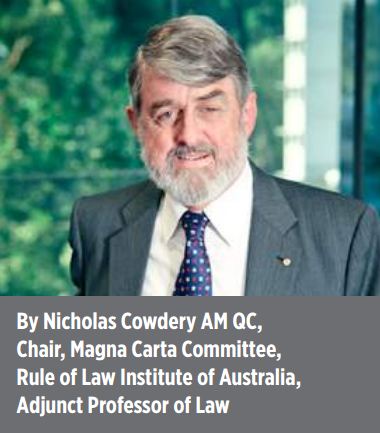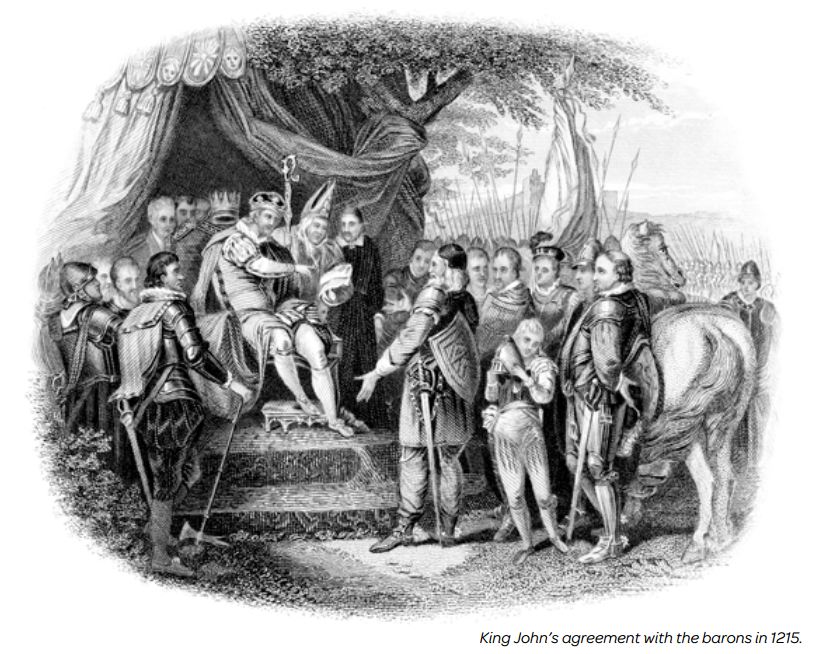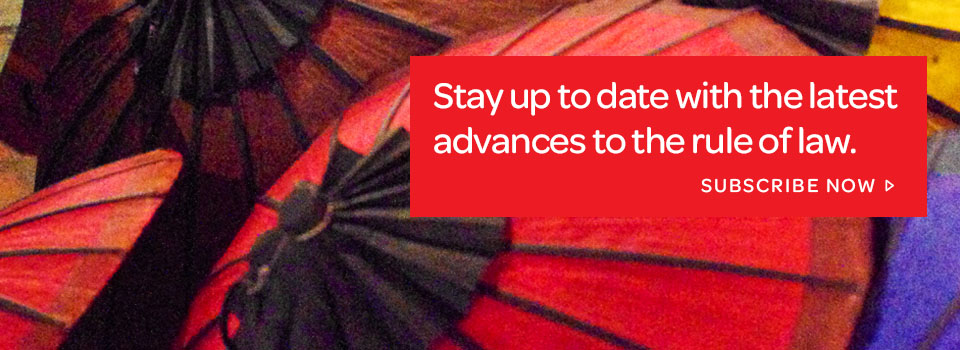what is the rule of law and how does it apply to the magna carta
Magna Carta and the rule of police force
05 June 2015 | Nicholas Cowdery AM QC

All educated persons, particularly (merely non only) those in places with an English heritage, think they know what the Magna Carta is and why it is important to our lives – but it is ever helpful to stop and think nigh objects that have passed into fable and that over time take acquired significance and value that the originators could never accept foreseen. A common view is that King John made an understanding with the barons in 1215, that the document became "law", it created rights, information technology has been construed and applied ever since and information technology is the source of most that is good in public administration — including democracy, the separation of powers, the dominion of law, the independence of the judiciary, trial by jury and equality earlier the police force. That is only partly true. The existent story is much more interesting (although mayhap not as satisfying), only in that location is infinite here to tell only some of it.
A document was sealed by King John on xv June 1215 at Runnymede (sometimes an island, sometimes a riverbank, unnamed until this upshot). It was on the River Thames between Windsor, his residence at the time and Staines; a skilful altitude from Westminster which was and so occupied by the barons and merchants. That certificate was the Lease of Liberties (non the Magna Carta) and that sealed copy has been lost.
The certificate contained 63 clauses, the commencement and most important granting liberties (freedoms from royal control) to the Church, not the barons. "Free men" (peradventure up to forty% of the population of England of betwixt two and iv one thousand thousand people) then had their liberties declared in subsequent clauses.
The Pope annulled information technology in Baronial 1215 and King John repudiated it in September – so information technology had a very brusk life.
Mayhap 30 copies of the Lease were made and they were however existence copied, economically on expensive vellum with many abbreviations to save infinite, in July. They were taken to county courts throughout the land to be read aloud in Latin and French. Simply iv of the 1215 documents are known and they were exhibited together for the showtime time in the British Library and House of Lords in Feb this year.
Rex John died in 1216 and his son and heir, Henry III (then only 9 years onetime), reissued the Charter of Liberties in that year and in 1217, just with only 37 clauses. Considering a smaller Charter of the Forests was issued at the same time as the reissue in 1217, the Lease of Liberties became known equally the Magna Carta – the big charter. So it has remained.
Magna Carta was reissued in 1225 (a fairly definitive version), 1234, 1237, 1253, 1265, 1297 and 1300. Ane from 1297 is in Parliament House, Canberra and that text (almost identical to the 1225) is the most ordinarily quoted.
And so the reality is that the name Magna Carta dates from 1217, it is to be found in many documents spanning 85 years and non all identical, information technology did not create much that was new just rather declared existing laws and usages and information technology has never been a "law" of the land. Its main other political party was the Church, non the barons. Its significance, however, lies non so much in the text simply in the principles backside the text – the values and concepts that support it.
The rule of police force is one of those concepts and information technology may conveniently be described in the words of the Secretary-General of the United nations:
"For the United Nations, the rule of police force refers to a principle of governance in which all persons, institutions and entities, public and private, including the State itself, are accountable to laws that are publicly promulgated, every bit enforced and independently adjudicated, and which are consistent with international human rights norms and standards. It requires, as well, measures to ensure adherence to the principles of supremacy of law, equality earlier the police, accountability to the constabulary, fairness in the application of the police force, separation of powers, participation in decision-making, legal certainty, abstention of arbitrariness and procedural and legal transparency."
The Magna Carta has provided inspiration and support for progressive evolution in governance worldwide since the Eye Ages. Information technology stands for:
- continuation of basic constabulary – of a framework for order and peace fashioned by and from the people – upon which contemporary laws are made and rest and which is innate and inalienable;
- the triumph of liberties over tyranny;
- the rule of police itself – that no one is higher up the police force, no matter how powerful, even a monarch, and that justice will be done according to certain laws that are knowable in advance;
- the value of democratic processes in the government of the people; - the value of the separation of powers;
- independence and professional competence of the judiciary;
- equality earlier the law and due process (including the presumption of innocence and burden of proof on the prosecution);
- trial past a jury of one's peers;
- "no taxation without representation"; - freedom from capricious penalisation and proportionality in sentencing.
It is also said to have been the origin of the police of trusts and an early case of the protection of women'south rights (in that widows were not to exist forced to remarry and would have their inheritances). It besides dealt with a multitude of local and temporal regulations that are of less indelible significance but which secured mutual freedoms. Magna Carta, as information technology has come to be understood and called upon over 800 years, operates as a shield against tyranny, abuse of power and oppression of the governed. Information technology has go the talisman of a society in which the spirits of tolerance and commonwealth reside. In the English common law arrangement, it is the touchstone of the rule of police and a standing inspiration to all.
Australia'south Magna Carta
In the 1930s the minor King'southward Schoolhouse in Bruton in Somerset in the English West Country acquired an original 1297 Magna Carta. In 1951 the impoverished school took it to the British Museum for hallmark, which was duly fabricated, with a view to sell to enhance money. It was formally identified as an original of the 1297 Magna Carta, at that time 1 of only two known to be (two others were discovered afterward). In that location is uncertainty nigh how it came into the schoolhouse's possession, but the all-time business relationship seems to be that in the decades before, the school'south lawyer, who had been keeping the document for someone else whose family unit had probably acquired it from Easebourne Priory in Sussex, put information technology into the school'southward documents box past mistake.
The British Museum was prepared to offer £ii,000-2,500. The school had it independently valued at £10,000 (£12,500 with seller'southward committee), only the British Museum would not move and the school engaged Sotheby's. After much manoeuvring (a story in itself) the Library Committee of the Australian Parliament purchased information technology in 1952 for £12,500 (15,672 Australian pounds) and the document is now on display in Parliament Business firm, Canberra. An area in Canberra near Old Parliament House has been designated Magna Carta Place.
The United states of america of America has some other original of the 1297 charter, purchased in 1983 by Ross Perot for $US1.5 million from the Brudenell family of Deene Park in Northamptonshire. In 2007 Perot sold it for $US21.three million to David Rubenstein, who has since gifted information technology to the United states National Archive.

Contact our Experts Now

Source: https://www.lexisnexis.com.au/en/insights-and-analysis/rule-of-law/2015/05jun2015-magna-carta-and-the-rule-of-law
0 Response to "what is the rule of law and how does it apply to the magna carta"
Post a Comment